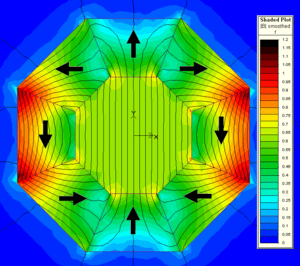MIT researchers devise a surprisingly simple but effective method for magnetically separating oil and water.
MIT researchers have developed a new technique for magnetically separating oil and water that could be used to clean up oil spills. They believe that, with their technique, the oil could be recovered for use, offsetting much of the cost of cleanup.
The researchers will present their work at the International Conference on Magnetic Fluids in January. Shahriar Khushrushahi, a postdoc in MIT’s Department of Electrical Engineering and Computer Science, is lead author on the paper, joined by Markus Zahn, the Thomas and Gerd Perkins Professor of Electrical Engineering, and T. Alan Hatton, the Ralph Landau Professor of Chemical Engineering. The team has also filed two patents on its work.
In the MIT researchers’ scheme, water-repellent ferrous nanoparticles would be mixed with the oil, which could then be separated from the water using magnets. The researchers envision that the process would take place aboard an oil-recovery vessel, to prevent the nanoparticles from contaminating the environment. Afterward, the nanoparticles could be magnetically removed from the oil and reused.
According to Zahn, there’s a good deal of previous research on separating water and so-called ferrofluids — fluids with magnetic nanoparticles suspended in them. Typically, these involve pumping a water-and-ferrofluid mixture through a channel, while magnets outside the channel direct the flow of the ferrofluid, perhaps diverting it down a side channel or pulling it through a perforated wall.
This approach can work if the concentration of the ferrofluid is known in advance and remains constant. But in water contaminated by an oil spill, the concentration can vary widely. Suppose that the separation system consists of a branching channel with magnets along one side. If the oil concentration were zero, the water would naturally flow down both branches. By the same token, if the oil concentration is low, a lot of the water will end up flowing down the branch intended for the oil; if the oil concentration is high, a lot of the oil will end up flowing down the branch intended for the water.
Orthogonal thinking
The MIT researchers vary the conventional approach in two major ways: They orient their magnets perpendicularly to the flow of the stream, not parallel to it; and they immerse the magnets in the stream, rather than positioning them outside of it.
The magnets are permanent magnets, and they’re cylindrical. Because a magnet’s magnetic field is strongest at its edges, the tips of each cylinder attract the oil much more powerfully than its sides do. In experiments the MIT researchers conducted in the lab, the bottoms of the magnets were embedded in the base of a reservoir that contained a mixture of water and magnetic oil; consequently, oil couldn’t collect around them. The tops of the magnets were above water level, and the oil shot up the sides of the magnets, forming beaded spheres around the magnets’ ends.
The design is simple, but it provides excellent separation between oil and water. Moreover, Khushrushahi says, simplicity is an advantage in a system that needs to be manufactured on a large scale and deployed at sea for days or weeks, where electrical power is scarce and maintenance facilities limited. “The process may seem simple,” he says, “but it is, inherently, supposed to be simple.”
In their experiments, the MIT researchers used a special configuration of magnets, called a Halbach array, to extract the oil from the tops of the cylindrical magnets. When attached to the cylinders, the Halbach array looks kind of like a model-train boxcar mounted on pilings. The magnets in a Halbach array are arranged so that on one side of the array, the magnetic field is close to zero, but on the other side, it’s roughly doubled. In the researchers’ experiments, the oil in the reservoir wasn’t attracted to the bottom of the array, but the top of the array pulled the oil off of the cylindrical magnets.
Leaving the lab
Whether the Halbach array would be the most practical way to remove oil from the cylindrical magnets in an actual oil-recovery system remains to be seen.
via MIT – Larry Hardesty
The Latest Streaming News: How to clean up oil spills updated minute-by-minute
Bookmark this page and come back often
Latest NEWS
Latest VIDEO








